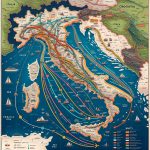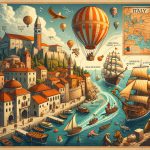Travelling from Croatia to Italy offers a unique opportunity to explore two of the most captivating and historically rich countries in Europe. From the stunning Adriatic Coast of Croatia to the charming, picturesque towns of Italy, this journey promises an unforgettable experience. The allure of this travel route lies not only in the diverse landscapes and cultural significance but also in the opportunity to immerse oneself in the local traditions, cuisine, and events that make these destinations so enticing.
Croatia and Italy each boast a wealth of history and cultural significance, with ancient ruins, medieval cities, and iconic landmarks awaiting visitors at every turn. Whether it’s exploring the ancient Roman amphitheater in Pula or wandering through the cobblestone streets of Florence, there is no shortage of awe-inspiring sights to behold. Moreover, the diverse landscapes – from the crystal-clear waters of the Adriatic Sea to the rolling hills of Tuscany – offer a visual feast for travelers.
As you plan your journey from Dubrovnik to Venice, it’s important to consider various transportation options, such as car rentals, train services, or ferry crossings. Each mode of transport has its own advantages and considerations when it comes to crossing borders and navigating unfamiliar territories. Understanding visa requirements and travel documents is essential for a smooth border crossing between Croatia and Italy. This article will provide valuable tips for minimizing potential delays or complications during this process.
Planning Your Itinerary
When planning your itinerary from Dubrovnik to Venice, it’s important to take into account the various modes of transportation available. Whether you prefer the flexibility of driving, the convenience of taking a train, or the scenic route offered by a ferry, each option offers its own unique advantages. When choosing the best route for your journey, consider factors such as travel time, cost, and the specific attractions you’d like to visit along the way.
If you opt for a road trip from Dubrovnik to Venice, you’ll have the chance to explore some picturesque towns and natural wonders. Consider making stops in Split to visit Diocletian’s Palace or to marvel at the stunning waterfalls in Plitvice Lakes National Park. In Italy, don’t miss the opportunity to visit Trieste for its blend of cultural influences and architecture or Verona, known for being the setting of Shakespeare’s Romeo and Juliet.
For those who prefer traveling by train, there are convenient connections available between major cities in both countries. From Dubrovnik, you can take a train to Zagreb before transferring to another one bound for Venice. This option is ideal for those who want to sit back and enjoy the views while leaving the navigation up to experienced conductors. Additionally, taking a ferry from Croatia to Italy offers a more leisurely travel experience with stunning coastal views along the Adriatic Sea.
No matter which mode of transportation you choose for your journey from Croatia to Italy, consider making an itinerary that includes these must-see stops along the way. Taking time to explore both countries ensures that you get a comprehensive taste of their rich history, culture, and landscapes. And remember that planning your route ahead of time will help ensure that you make the most out of this epic journey.
Border Crossing
When traveling from Croatia to Italy, crossing the border is an inevitable part of the journey. Navigating the process can be relatively straightforward as long as travelers are aware of the visa requirements and have the necessary travel documents in order.
As both Croatia and Italy are part of the Schengen Area, which allows for passport-free travel between member countries, travelers from certain countries may not need a visa for short stays. However, it is crucial to check visa requirements based on your nationality before planning your trip.
To avoid potential delays and complications during the border crossing, it’s essential to have all the required documentation readily available. This includes a valid passport that will not expire within three months of your departure from the Schengen area, proof of sufficient funds for your stay, travel insurance, and a return ticket or proof of onward travel.
Additionally, it’s important to be aware of any temporary border control measures that may be in effect at the time of your travels, as these could impact your journey.
Travelers should also ensure they are familiar with any restrictions or regulations regarding items that they are bringing across the border, such as duty-free allowances for alcohol and tobacco. Being well-prepared with all necessary documents and knowledge about potential border control measures will help make the process of crossing from Croatia to Italy go smoothly.
| Visa Requirements | Border Control Measures |
|---|---|
| Certain nationalities may be exempt from needing a visa for short stays | Temporary border control measures may impact travel |
| Valid passport with at least three months validity beyond departure date required | Be aware of any regulations regarding items brought across the border |
Transportation Options
When traveling from Croatia to Italy, it’s important to consider the various transportation options available for getting around both countries. In Croatia, travelers have the choice of rental cars, local buses, and train services to explore the beautiful landscapes and vibrant cities.
The same goes for Italy, where efficient public transportation systems and well-maintained roads make it easy to navigate the country. Each mode of transportation has its own pros and cons, so it’s essential to weigh them carefully before deciding on the best way to travel between the two countries.
One of the most popular choices for traveling between Croatia and Italy is by train. The train network in both countries is well-developed, providing convenient connections between major cities and offering a scenic journey through picturesque countryside. Travelers can enjoy comfortable seating, onboard amenities, and frequent departures when opting for trains as their mode of transportation. Additionally, traveling by train reduces the stress of navigating unfamiliar roads or dealing with traffic.
For those who prefer more flexibility in their travels, renting a car is an excellent option for exploring Croatia and Italy at their own pace. Renting a car allows travelers to visit off-the-beaten-path destinations, stop at charming villages along the way, and take in breathtaking views that may not be accessible by public transportation.
However, it’s important to familiarize oneself with driving regulations in both Croatia and Italy, as well as any potential tolls or parking restrictions.
When choosing how to get around Croatia and Italy, taking into account ferry services should also be considered if planning to visit coastal towns or islands in either country. Ferries provide an enjoyable way to travel across the Adriatic Sea while taking in stunning views of the coastline.
Whether visitors are arriving from Split or Dubrovnik in Croatia or departing from Venice or Ancona in Italy – ferries offer a unique experience that should not be overlooked when planning an itinerary encompassing both countries.
| Transportation Option | Pros | Cons |
|---|---|---|
| Train | Convenient connections between major cities; Scenic journey through picturesque countryside; Comfortable seating; Frequent departures | Limited access to remote areas; Fixed schedules; Subject to potential delays |
| Rental Car | Flexibility in travel plans; Ability to reach off-the-beaten-path destinations; Stunning views accessible by private vehicle only | Potential traffic congestion; Parking challenges in popular tourist areas; Requires familiarity with driving regulations |
| Ferry | An enjoyable travel experience offering stunning coastal views Consistent with Croatian tradition ; Limited access ; Schedules might be subject change due weather conditions |
Accommodation
When traveling from Croatia to Italy, finding the perfect accommodation can greatly enhance the overall experience. Both countries offer a wide range of options for travelers, from boutique hotels to traditional agriturismos. Here are some tips and suggestions for finding the ideal place to stay:
- Research in Advance: Before embarking on your journey from Croatia to Italy, take the time to research and book accommodations in advance, especially during peak travel seasons and popular tourist destinations. This will ensure that you have a comfortable place to stay without any last-minute hassles.
- Consider Unique Stays: In Croatia, consider staying at a charming guesthouse in Dubrovnik or a traditional stone farmhouse in Istria. In Italy, opt for an agriturismo in Tuscany or a historic palazzo in Venice for an authentic experience.
- Location is Key: When choosing accommodation, consider its proximity to local attractions and transportation hubs. This will make it easier for you to explore the area and continue your journey from one destination to the next.
In addition to traditional lodging options, both Croatia and Italy offer unique experiences such as staying at vineyard estates or even historic castles. No matter your preference, there is something for everyone when it comes to finding the perfect place to stay while traveling between these two stunning countries.
Whether you prefer a cozy bed and breakfast nestled in the Croatian countryside or a luxurious boutique hotel overlooking the canals of Venice, there is no shortage of unforgettable accommodation options waiting for you on your journey from Croatia to Italy. By carefully choosing where you stay, you can immerse yourself in the local culture and create lasting memories along the way.
Culinary Delights
Exploring Croatian Cuisine
When it comes to experiencing the flavors of Croatia, travelers can look forward to a diverse and delicious culinary scene. The coastal region of Istria is known for its truffles, olive oil, and fresh seafood, offering a unique blend of Mediterranean and Italian-inspired dishes.
In Dalmatia, traditional specialties like peka (a slow-cooked meat and vegetable dish) and seafood risottos showcase the region’s rich gastronomic heritage. Travelers should not miss the opportunity to sample local wines, such as the renowned Plavac Mali red wine or the crisp Posip white wine.
Indulging in Italian Gastronomy
As travelers make their way into Italy from Croatia, they will be greeted by an array of delectable dishes that vary from region to region. In Veneto, the birthplace of tiramisu, visitors can savor classic dishes like risotto, salted cod (baccalà), and Sarde in saor (sweet and sour sardines).
Tuscany offers an abundance of hearty fare, including ribollita (a hearty vegetable soup) and bistecca alla fiorentina (grilled T-bone steak). Of course, no trip to Italy would be complete without enjoying gelato, pasta dishes galore, and world-famous pizza.
Food Tours and Culinary Experiences
To truly immerse oneself in the culinary delights of both Croatia and Italy, travelers can partake in food tours and cooking classes along their journey. From truffle hunting experiences in Istria to pasta-making workshops in Tuscany, these activities provide an authentic taste of each region’s food culture.
Whether it’s savoring freshly caught seafood at a local restaurant or learning how to prepare traditional Dalmatian peka under the guidance of a skilled chef, these experiences add a flavorful dimension to any trip from Croatia to Italy.
Cultural Immersion
Cultural immersion is an integral part of traveling from Croatia to Italy, allowing visitors to truly embrace the rich traditions and local events that define these two countries. From vibrant festivals to traditional art exhibitions, there are numerous opportunities for travelers to connect with the cultural heritage of Croatia and Italy.
In Croatia, visitors have the chance to immerse themselves in local traditions by attending events such as the Dubrovnik Summer Festival, which showcases a variety of performing arts including theater, music, and dance. Additionally, exploring the historic city of Split offers insight into ancient Roman traditions and architecture, while the annual Sinjska Alka event allows travelers to witness a captivating equestrian competition that dates back over 300 years.
Italy also boasts a wealth of cultural events that provide unique insights into local traditions. For example, Venice’s Carnival is a world-renowned festival featuring elaborate costumes, masked balls, and lively parades that reflect the city’s colorful history. In Verona, visitors can experience the enchanting Opera Festival held in the ancient Roman amphitheater during the summer months, offering an unforgettable cultural experience.
To fully embrace these local traditions and events during your journey from Croatia to Italy, consider participating in authentic experiences such as visiting local markets and taking part in traditional cooking classes. These immersive activities allow travelers to connect with locals and gain firsthand knowledge about regional customs and culinary practices.
- Attending cultural festivals.
- Exploring traditional art exhibitions.
- Participating in local markets.
- Joining traditional cooking classes.
Safety and Practical Tips
In conclusion, traveling from Croatia to Italy is an extraordinary experience that offers a rich blend of history, culture, and diverse landscapes. Whether you choose to explore the stunning Adriatic Coast or meander through the rolling hills of Tuscany, there are countless opportunities for unique and unforgettable experiences along the way. As you plan your itinerary, it’s important to consider the various transportation options available, as well as accommodations and culinary delights that will enhance your journey.
When navigating the border crossing between Croatia and Italy, it’s crucial to be prepared with the necessary travel documents and to familiarize yourself with any visa requirements. By doing so, you can help ensure a smooth transition between these two beautiful countries.
Additionally, staying informed about safety tips and practical considerations can contribute to a worry-free travel experience. From understanding language barriers to being aware of emergency contacts and healthcare options, taking a proactive approach to safety can provide peace of mind while exploring new and unfamiliar destinations.
Ultimately, traveling from Croatia to Italy is not just about reaching your final destination-it’s about embracing the journey itself. By immersing yourself in local traditions and events, embracing regional cuisine, and seeking out authentic cultural experiences, you can make the most of this enchanting voyage. Whether you’re a solo traveler or part of a family adventure, prioritizing safety and staying informed will allow you to fully enjoy everything that Croatia and Italy have to offer.
Frequently Asked Questions
How can you travel from Croatia to Italy?
You can travel from Croatia to Italy in a few different ways. One option is to take a ferry, which is available from various ports along the Croatian coast, with destinations such as Ancona, Bari, and Venice in Italy.
Another option is to drive across the border, using one of several land border crossings between the two countries. Additionally, there are also flights available between various cities in Croatia and Italy.
How long is ferry ride from Croatia to Italy?
The length of the ferry ride from Croatia to Italy can vary depending on the specific route and ports involved. Generally, ferry rides from Croatian ports to Italian ports can range from around 6-10 hours. Travelers should check schedules and availability for specific routes when planning their journey.
Can I travel to Croatia from Italy by train?
Yes, it is possible to travel to Croatia from Italy by train. There are direct train services connecting major cities in both countries, such as Zagreb in Croatia and Venice in Italy.
Travelers can also make connections through other European cities if they are not on a direct route. The journey times can vary depending on the specific route, but rail travel provides an alternative way to move between the two countries for those who prefer not to fly or drive.

I’m a passionate traveler, writer, and Italophile. My fascination with Italy’s history, art, and culture has led me on countless adventures across the Italian landscape. Through “I Live Italy,” I share my love for this extraordinary country and aims to inspire others to explore its boundless beauty.




